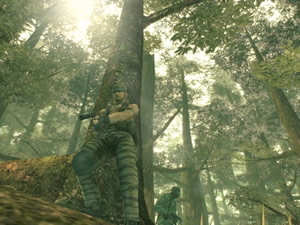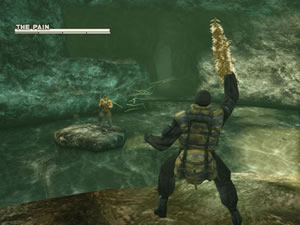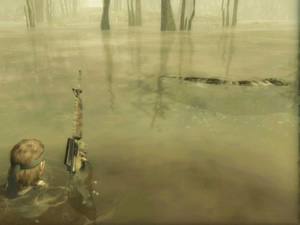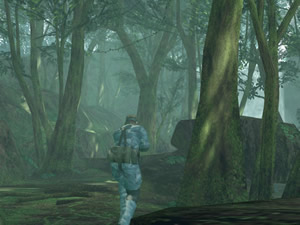New flavors and old poisons.
According to Christianity, the Devil, disguised as a snake, tempted Eve into seeking forbidden knowledge and so managed to estrange the first humans from their God, the boss of bosses. But the Gnostics thought the serpent was the herald of the true God, Monoimus, and his message liberated humanity from the clutches of Yaldabaoth, the Old Testament God, who was seen by the Gnostics as Satan.
At least, that’s what they told me on a weird public access show last night, although anyone who has played Konami’s new Metal Gear Solid 3: Snake Eater for the PS2 knows how it really went down, because director/high priest Hideo Kojima explains it all, over and over again. While we aren’t about to tell you who Eve really works for or what forbidden knowledge is at stake, we can tell you that Snake’s latest adventure is one of the hardest, longest, and solidest Metal Gear experiences yet.
If you’ve played a Metal Gear game before (i.e. you have a pulse and opposable thumbs), you should be aware of Kojima’s inclination towards cinematic game design. But Kojima takes his passion for film farther than cut-scenes and plot twists; he seeks to integrate plot and circumstance into the gameplay itself, thereby creating something more than the sum of its parts. And as often as Kojima gets the balance right, he falters.
Snake Eater‘s story takes place in Russia circa 1960, dropping you into Snake’s combat boots as he single-handedly seeks to eliminate a dangerous American defector and destroy the Metal-Gear prototype, known as the Shagohad, before it can enter mass-production. To succeed, Snake must learn to survive in a dangerous Russian jungle, sneak past or slaughter a million enemy troops, and defeat an awesome team of Cobra commandos. It’s a pretty typical Metal Gear plot filled with plenty of twists and turns.
However, the greatest obstacle to Snake’s mission – and your potential enjoyment of the game – is Kojima’s need to burden his work with awful, spiritual ramblings of interminable length. All of the gameplay (and most of the game itself) is based on the ostensible spy fiction involving double-agents, metal gears, Cold War tensions and pages of obtuse dialogue. Every once in a while, this or that character will start talking about moral relativism, objectivity and the will of the secretive Philosophers, and then they won’t stop. By the time the final credits roll, Kojima’s tale is completely lost in space.
Never before has a developer been more present in his game than Kojima is in this one, and he has a lot he wants to tell you about movies, religion, politics, and spirituality. Where some artists present their public with images and works open to interpretation, Kojima plants you in his world and then speaks to you directly through his characters. The result is a game that often can’t decide if it wants to be played or to play you. Caught between the two, you’ll occasionally feel victimized by Kojima’s ridiculous, lengthy moral diatribes, which gather steam as the game progresses only to explode in a preposterously long-winded wrap-up. It’s as frustrating as it is rewarding.
The changes made to the gameplay, though, are sure to tickle your fancy. Since much of Snake Eater takes place in the jungle, Snake doesn’t have his usual assortment of corners to hide around or air-shafts to crawl through. Instead, he’ll make like a reptile and have to blend into his surroundings using camouflage. Snake starts the game with several different patterns for his face and uniform, and can find others throughout the various levels. If Snake’s camo matches his surroundings, he’ll become virtually undetectable by nearby enemies, provided he lies prone like a snake in the grass. It’s a very cool new twist that adds a great deal to the gameplay.
 Snake Eater is also completely devoid of health-packs. Rather, Snake regenerates health based on his stamina level. If Snake’s stamina gets too low, he won’t heal, his vision will become obscured, and he won’t be able to hold a gun steadily. To replenish stamina, Snake has to eat. His options include rations, instant noodles, mushrooms, snakes, rats, rabbits, goats, gators, fruit and just about anything else he can get his hands on. He may either kill or tranquilize his food, although it will keep indefinitely if tranqued. When Snake eats something he likes, he says so and gets a large stamina boost. In turn, when he eats something foul, like a spider, he gags and only receives a little stamina. If Snake eats something rotten or poisonous, he’ll become ill and lose stamina by the second.
Snake Eater is also completely devoid of health-packs. Rather, Snake regenerates health based on his stamina level. If Snake’s stamina gets too low, he won’t heal, his vision will become obscured, and he won’t be able to hold a gun steadily. To replenish stamina, Snake has to eat. His options include rations, instant noodles, mushrooms, snakes, rats, rabbits, goats, gators, fruit and just about anything else he can get his hands on. He may either kill or tranquilize his food, although it will keep indefinitely if tranqued. When Snake eats something he likes, he says so and gets a large stamina boost. In turn, when he eats something foul, like a spider, he gags and only receives a little stamina. If Snake eats something rotten or poisonous, he’ll become ill and lose stamina by the second.
When this happens, Snake has to heal himself by entering the new Cure screen and using whatever supplies he has to fix himself up. For example, if Snake is somehow bitten by a king cobra in the heart of Russia, he’ll need to use serum to neutralize the venom. Of course, Snake is capable of sustaining all sorts of other injuries like gunshot wounds or nasty burns, and so comes equipped with a handy first-aid kit. Using various bits of the kit, you can literally patch the guy up as he falls apart.
While the Cure system is certainly an interesting idea, none of Snake’s injuries will ever linger or really affect his handling. Since you can basically switch to the Cure screen at any time and fix Snake’s six gashes, two broken limbs, and burned face instantly, the Cure system has the instant-fix feel that made health-packs so unrealistic in the first place. It’s better than those, at least.
It’s said that time heals all wounds, and in Snake’s case that’s especially true. If you don’t feel like stitching him up, you don’t have to, because Snake is one tough mother as long as he’s had a healthy rat breakfast. If taking damage actually meant anything, maybe the Cure system would have more gravity, but since Snake can take a bullet better than the Terminator, it winds up feeling more novel than necessary. Still, the Cure and Food systems are great gameplay concepts that are fairly well implemented.
When it comes to getting scrappy, Snake has a few new moves. If Snake is bare-handed or wielding smaller weapons like pistols or a combat knife, he can use his Close Quarters Combat training. This system is based on pressure-sensitive button taps and can be used on almost any enemy at any time. For example, to grab and hold an enemy you must lightly press and hold the Circle button. Tapping L3 leads to an interrogation attempt, while pressing Circle firmly will slit the poor soul’s throat. Holding R1, Square, and Circle will let Snake use his enemy as a human shield. Not exactly intuitive, but it sure can be fun.
 To balance Snake’s newfound abilities, the classic radar with the field-of-vision cones has been completely removed. Ironically, it turns out that these cones were what made Metal Gear‘s fixed camera system so bearable in previous versions. Since Snake still can’t move while in first-person view mode (argh!) and can’t see farther than ten feet ahead, it can be really difficult to get a bearing on your enemies.
To balance Snake’s newfound abilities, the classic radar with the field-of-vision cones has been completely removed. Ironically, it turns out that these cones were what made Metal Gear‘s fixed camera system so bearable in previous versions. Since Snake still can’t move while in first-person view mode (argh!) and can’t see farther than ten feet ahead, it can be really difficult to get a bearing on your enemies.
It follows then, that being stealthy has never been more difficult. You’ll get plenty of other gadgets to help track down enemies, like a motion sensor and heat vision goggles, but these don’t really help much when you enter a new area and, due to the fixed camera perspectives, have absolutely no idea if guards are staring at you just off-screen.
On the other hand, since Snake can now take a Walmart’s worth of bullets and enemies eventually stop coming once you kill enough of them, Snake Eater is actually easier if you treat it like a straight up action game. The emphasis seems to have shifted somewhat away from stealth, which is weird to say about a Metal Gear game.
Some classic Metal Gear staples are still intact, though, and in many ways better than ever. The Metal Gear games didn’t invent boss fights, but every couple of years they completely reinvent them. Snake Eater contains two of the best boss battles I’ve ever experienced. Most are complex games of cat-and-mouse (one took me literally two hours to complete) and all are exquisitely satisfying. We’d tell you more, but the less you know going in, the better.
Know this, though – Snake Eater looks amazing. The jungle foliage, swamps, lighting, textures, and enemies all look better than they have any right to. If you think you know what the PS2 is capable of, Snake Eater will prove you wrong, because it is the best looking Playstation 2 game thus far. It becomes clear as you see more and more of the game that it doesn’t so much use new effects as use old ones better than anyone else. From top to bottom, beginning to end, Snake Eater is an expertly crafted game, and it shows.
Likewise, it sounds great. The voice acting is top-notch, the music is well produced and the game’s sound effects are all high quality. Sound is more than just an ambient effect in Snake Eater – it’s a play mechanic. I’ve never listened more in my life to a game than I did playing Snake Eater. Food makes noise, enemies make noise, and you’ll find yourself running from certain sounds while stalking others.
 Snake Eater is a notably harder and longer experience than past MGS games, taking us around thirty hours to beat and providing several unforgettable gameplay experiences. The levels all seem to have been designed with snakes in mind, since they’re completely linear. In some cases there are extra areas to explore, which is nice, but Snake never has more than one objective and it almost always involves going somewhere.
Snake Eater is a notably harder and longer experience than past MGS games, taking us around thirty hours to beat and providing several unforgettable gameplay experiences. The levels all seem to have been designed with snakes in mind, since they’re completely linear. In some cases there are extra areas to explore, which is nice, but Snake never has more than one objective and it almost always involves going somewhere.
Other than the single-player campaign, you can also play a charming mini-game known as Snake vs. Monkey. Although it’s more of a goofy diversion than anything else, the monkeys themselves are hilarious and worth checking out. You can also download new camouflage, although you’ll find plenty throughout the course of the game.
Metal Gear Solid 3: Snake Eater provides some incredible, one-of-a-kind gameplay experiences at the price of dealing with Hideo Kojima’s exhausting ego. You have to give credit to the guy for really trying to expand the horizons of video game storytelling, but he just doesn’t know when to shut up and let the audience figure things out for themselves. The result turns what should be an engaging, clever and straightforward story about a super-agent out to save the world into a never-ending, philosophical after-school special. Luckily, the gameplay is still so good that we’ll surely forget Kojima’s ego and his lack of tact when Snake’s next course is served.
-
Eating is fun...and good for you, too
-
Camouflage!
-
Incredible boss fights
-
Awesome visuals
-
Important sound effects
-
Long and difficult
-
Which can be said about the story, too
-
Still caní¢â‚¬â„¢t move in first-person
-
Lack of radar cones + fixed perspective = frustration











